Operation Nimrod - The Iranian Embassy Siege
The breaking of a terrorist siege in the heart of London in 1980 catapulted the normally secretive SAS onto the world stage. The audacious daylight assault, carried out in the full glare of media scrutiny, made the Regiment and it's motto, 'Who Dares Wins' an indelible part of UK culture. The techniques used in the operation were quickly studied and copied by other special forces and counter-terrorism units around the world.
The Siege
11:30am Wednesday April 30th, 1980 : Six Iranian gunmen force their way into the Iranian Embassy at Princes Gate, London. They overpowered PC Trevor Lock of the diplomatic protection squad and took a total of 26 people hostage. Amongst the hostages are men from the BBC who were arranging visas.
The terrorists, who called themselves the 'Democratic Revolutionary Front for Arabistan' were protesting against the oppression of Khuzestan by the then Iranian leader - Ayatollah Khomeini. They demanded the release of 91 political prisoners who were imprisoned in Iran. They also demanded a plane to fly themselves and the hostages out of the UK.
Not long after the initial seizing of the Iranian embassy, the police cordoned off the area. Police snipers took up positions overlooking the building. The UK government's emergency committee, COBRA, was setup to monitor and manage the evolving crisis.
Alert The Special Air Service!
At their base in Hereford, the SAS Counter-Terrorism team of the Special Air Service was put on high alert. B Squadron, who were during their stint on the Anti-Terrorist team, sped down the motorway to London. The SAS moved into a building close to the Iranian Embassy and quickly formulated an Immediate Action (IA) plan. The IA is put into play if the situation deterioates before a proper assault plan can be drawn up e.g. if the terrorists snap and start shooting hostages. The SAS prefer to have the time to gather good intel and formulate a detailed assault plan.
As the police negotiators began their delicate dialogue with the hostage takers, MI5 specialists lowered microphones down the embassy's chimneys. A road drill outside was used to cover the sounds of holes drilled through the walls of adjacent buildings for eavesdropping devices.
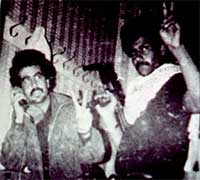
Salim (with phone) and terrorist colleague inside the embassy. |
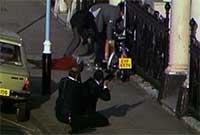
Covered by armed police, Abbas Lavasani's body is removed from outside the embassy. |
The SAS planners studied blueprints and consulted with the embassy janitor, building a picture of the building's interior, doors and windows. Preparations included small team of SAS men sneaking onto the roof of the embassy at night where they checked out potential entry points.
In between planning and standing-to on alert for immediate deployment, the SAS troopers kept boredom at bay by watching the Snooker championships on tv.
The terrorists were led by Awn Ali Mohammed, 27, who was code named 'Salim'. Over the first few days of the siege, Salim released several women hostages and a BBC employee who feigned stomach cramps in order to be released. By Monday, and with no sign of his demands being met, Salim's mood changed for the worse and tensions rose. Salim threatened to shoot a hostage. Abbas Lavasani, an Iranian who had drawn the ire of the hostage-takers due to his animosity towards them was separated from the rest of the hostages. At noon 3 shots were heard from within the embassy and later that evening Lavasani's body was pushed out the front door.
The terrorists had now crossed the line. UK policy was not to use force unless hostages had either been killed or where at immanent risk of being killed. By killing a hostage, the terrorists had essentially forced the government's hand.
COBRA responded to the shooting by authorising the use of force to end the siege and release the hostages. Whilst negotiations continued with the terrorists, this time with the aim of stalling for time, operational control was handed over from the MET to the MOD. The SAS were now ordered to go in.
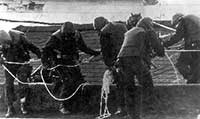
SAS assault team prepares to abseil down from the roof of the embassy |
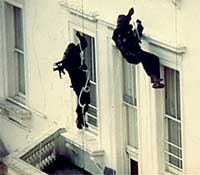
SAS assault team roping down onto the rear balcony. |
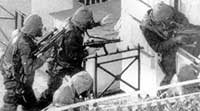
SAS assault teams enter through the embassy windows. Note large torch attached to the MP5 on the left trooper. |
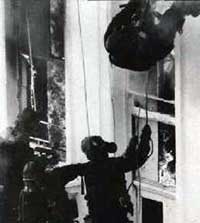
An entangled SAS trooper tries to free himself from his abseil rope and avoid the flames. |
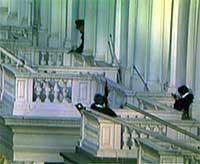
A still-armed PC Trevor Lock appears at a front window moments after the SAS had rescued him. Police marksmen cover him from the next door balconies. |
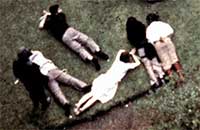
The hostages were handcuffed and spread-eagled in the rear garden of the embassy. |
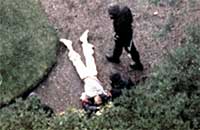
One of the terrorists had hid himself amongst the hostages but was soon identified and separated. |
The SAS Go In
As the terrorist leader was kept busy on the phone with negotiations, the SAS assault teams moved to their start positions. 'Operation Nimrod' as the hostage rescue mission was code named, called for the embassy to be stormed from all sides, with multiple assault teams simultaneously entering on all floors.
- One team would enter down a stairway from the roof, lowering a large explosive device down through the skylight to cover their entry and cause maximum confusion
- Another team would blow in the first floor windows at the front of the embassy and enter via the balcony
- A further team would sneak into the embassy's rear garden and blow the patio doors open, then clear the ground floor and hold the main staircase. Part of this team would also act as a reserve force and hostage reception team.
- Teams on the roof would abseil down to the 2nd and 1st floor rear balconies and smash their way in
- Another team would enter the ground floor via the rear doors and clear the basement rooms.
As one of the rear teams abseiled down the building, one trooper accidentally put his boot through a window. Salim broke off his conversation with the police negotiator to investigate. The SAS commander realised the mission had been compromised, and even though not all teams were in position he issued the 'go! go! go!' command over the radio.
The team on the roof blew their charges down the skylight, shaking the entire building and sending a plume of smoke up into the blue sky.
Another massive explosion blasted open a first floor window on the front of the embassy and a 4-man team leapt through it into the library. Inside was BBC sound man Sim Harris who was quickly ushered out to the relative safety of the balcony. Moving into the corridor, the team shot dead a terrorist who had fled into a side room.
Inside a room on the first floor, Salim, the terrorist leader made a move towards the window. PC Trevor Lock tackled him, drew his pistol, which he had kept hidden since the siege began, and the 2 men began to grapple each other. Moments later two SAS men entered the room. They ordered Locke to roll clear of Salim and as soon as he was clear Salim was killed with a quick burst of fire from the trooper's MP5 sub machine gun.
At the rear of the embassy, the assault had hit a snag - literally. One SAS trooper had gotten tangled in his abseiling gear and was hanging halfway down the wall. To make matters worse, stun grenades that had been lobbed in through smashed windows below him had set curtains alight and the flames were licking up and roasting him alive. His colleagues managed to cut him free and he dropped unceremoniously onto the ground.
Inside the Telex room on the 2nd floor, the terrorists began firing indiscriminately at their captives, killing one and wounding another. Before the SAS burst into the room the terrorists threw their weapons down and hid themselves amongst their hostages. In the most controversial incident of the siege, the SAS put the 2 terrorists against the wall and shot them.
With all hostages secured, the reserve teams were brought in to assist in bringing them out. Troopers lined the central staircase as each hostage was roughly bundled down the stairs and out the rear doors to the back garden. Half way down the stairs, a terrorist was spotted amongst the hostages. He had a Russian assault grenade gripped tightly in his hand. Unable to open fire without risking hitting the hostages or other troopers, one SAS man clouted the terrorist with his MP5 stock. As soon as the man hit the floor at the base of the stairs, several SAS troopers opened fire, killing the man instantly.
Once outside, the hostages were all handcuffed and made to lay down. A quick head count revealed that there were too many hostages. The BBC sound man, Sim Harris identified another terrorist who was masquerading as a hostage. It's said that one SAS trooper separated the terrorist and led him back into the embassy, presumably to finish him off. Colleagues with cooler heads prevented him from doing so and the terrorist was properly arrested. Fowzi Nejad, the only surviving terrorist, was later sentenced to life imprisonment for his part in the siege.
With all hostages and terrorists accounted for, the police retook control of the area and the SAS withdrew from public view. Their once low profile, however, had been changed forever and the SAS was now a household word. The six-day siege had been busted in under 11 minutes. Not for the last time, however, controversy raged over the SAS's methods, particularly when dealing with unarmed terrorists. One thing, however, was clear : Britain had drawn a line in the sand with regards to international terrorism. Terrorists now knew that if they undertook an operation against British interests that the UK would respond with deadly efficiency.
| Related DVD : The Iranian Embassy Siege This excellent documentary takes a detailed look at the Iranian Embassy siege and the dramatic intervention by the SAS. Includes interviews with the SAS troopers who stormed the embassy, plus input from the hostages and police negotiators. This DVD is highly recommended and well worth picking up. |








